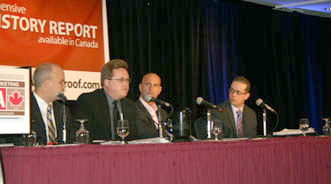Canadian CPO Experts Lend Tips on Certified Market

By subscribing, you agree to receive communications from Auto Remarketing and our partners in accordance with our Privacy Policy. We may share your information with select partners and sponsors who may contact you about their products and services. You may unsubscribe at any time.
TORONTO –
When it comes to the certified pre-owned market, Toyota Canada’s Mitch Gauthier said his company has found that Canadian consumers place the greatest importance on three key benefits of the automaker’s CPO program.
Gauthier, the company’s manager of pre-owned sales, said that according to a survey of Toyota Canada’s CPO customers, the aspect of the program they value the most is the 127-point inspection, followed by the factory warranty/roadside assistance and the ability to access a national body of dealers to get repairs done.
This piece of insight was among many tips and strategies shared by a CPO panel at the recently held Auto Remarketing Canada 2011 conference in Toronto.
Joining Gauthier on the “Certified Pre-Owned Sales and Operations: Opportunity to Grow Dealer Sales and Increase Brand Loyalty” panel discussion were Rob Hodge, senior manager of used vehicle operations for Honda Canada Finance; Pat Patsakos, general manager of Mississauga Honda; and Doug McDougall of Don Valley North Toyota.
It was moderated by Bill Zadeits, conference co-chair and associate publisher of Auto Remarketing Canada.
These leaders delved into a number of certified topics, including their CPO Web efforts, inventory sourcing and CPO benefits.
Starting with the online arena, Patsakos stressed that at his store, “We are very much Internet-based for our CPO advertising.” In fact, his dealership has large sections of its website dedicated to educating consumers about the certified market.
Subscribe to Auto Remarketing to stay informed and stay ahead.
By subscribing, you agree to receive communications from Auto Remarketing and our partners in accordance with our Privacy Policy. We may share your information with select partners and sponsors who may contact you about their products and services. You may unsubscribe at any time.
Gauthier noted that Toyota Canada, which rolled out a new ad campaign in March 2010 when it re-launched its CPO program, markets its certified inventory online via several avenues, including automotive and non-automotive sites and search-engine marketing.
The company also has a dedicated CPO site, and all ads on third-party sites click back to the CPO site.
Next up, the panelists were asked about what an ideal number of photographs to post with certified inventory online would be.
Hodge started off by emphasizing that photos need to be comprehensive and fresh. Gauthier suggested that 10 to 20 photos work well, with an average of 15 being ideal.
McDougall also found 15 to be the best number, but stressed that dealers should not go overboard.
“The customer sees too many, and they only click a few,” he noted.
Meanwhile, Patsakos recommended a range of 12 to 15 pictures.
Moving along, the experts went on to share their thoughts about video walk-arounds for CPO inventory.
Patsakos, for example, said that at his store, “It’s been pretty successful … and the customer seems to be responding.”He did emphasize that it has to be personal and that his tools of choice for video are a smartphone or Flip camera.
Continuing on, the panelists talked about what makes CPO a strong offering. Hodge pointed to the peace-of-mind that the certified offering provides and also cited the warranty. Gauthier shared the aforementioned three findings of Toyota Canada’s CPO customer survey, while Patsakos said that certified cars give consumers more bang for the buck.
“The CPO (segment) has allowed the customers to get more car than they came in for,” Patsakos shared. “We can give them more car than they bargained for, at a fair price.”
Next up, the panelists shared some strategies when it comes to certified inventory acquisition. McDougall talked about how his store’s service personnel are given incentives if they are able to service customers to trade in their CPO-worthy vehicles that they bring into the shop.
He indicated that “it makes sense” to buy such used inventory from service customers because then the dealership will know the full story of the vehicle since the car has been in the store’s service shop.
Patsakos said his dealership has a devoted used-car inventory manager whose sole duty is to source used cars.
“To us, the most critical part of selling a used car is having the right car,” Patsakos emphasized.
Wrapping up, the two dealership executives then gave some parting advice on CPO strategies for success.
First, McDougall advised dealerships to pay for cars within the house, referring to acquiring inventory from existing customers who visit the service shop.
Secondly, he advised that when a dealership decides to keep a used car and not wholesale it, go full throttle, pay the money and recondition it to the best it can be.
“When we decide to keep the car, we marry the car,” he shared.
Next, among the points Patsakos made were his suggestions that dealers hone in on inventory management, study analytics and understand the market.


